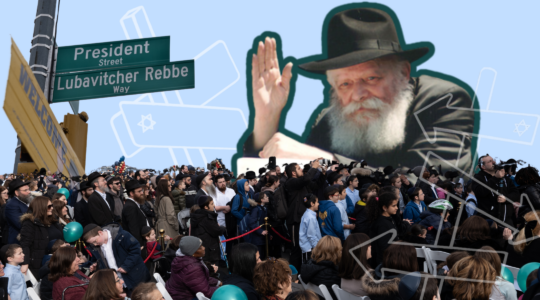With the religious landscape in America in the throes of dramatic change — it is less Christian, more Muslim and far more religiously unaffiliated than it was just seven years ago — the Jewish community has, perhaps surprisingly, remained stable.
The country’s Jewish population ticked up ever so slightly from 2007, when it represented 1.7 percent of all U.S. adults, to 1.9 percent in 2014.
In addition, of all faith groups, Judaism has among the highest rates of retention, a fact that runs counter to a widespread trend of people leaving the religion of their childhood in a search for spiritual connection. Seventy-five percent of Jews surveyed continue to identify with their childhood faith. As religious identity becomes increasingly fluid — “religious switching,” the demographers call it — only Hindus (80 percent) and Muslims (77 percent) have higher retention rates than Jews.
These are several of the takeaways from a major study of some 35,000 Americans released this week by the Pew Research Center, the second such massive survey in the last seven years. In fact, one of the study’s authors, Alan Cooperman, Pew’s director of religion research, hailed the Jewish community’s stability.
“For Jews, the population figure may be a surprise,” he told The Jewish Week on the eve of the study’s release. “The big long-term trend is that the Jewish population has been on the decline from the 1950s, when Jews represented 3 to 4 percent of the American population. It has dropped since then. Here, we’re seeing stability.”
But despite the relative demographic stability of the Jewish community, the changes at play in the wider religious landscape will likely test Jewish leaders when it comes to community relations and Israel. They will, given the emerging makeup of America’s religious terrain, almost certainly come under increasing pressure to make Israel’s case persuasively and to forge new coalitions to ensure communal priorities.
The Pew study, “America’s Changing Religious Landscape,” finds that the percentage of American who identify as Christian has dropped by nearly 8 points, from 78.4 percent in 2007 to 70.6 percent in 2014. At the same time, the percentage of Americans who say they are atheists, agnostics or “nothing in particular” — secularists who are generally believed to be less pro-Israel than more church-going Americans — spiked nearly 7 points, from 16.1 percent to nearly 23 percent. http://www.pewforum.org/2015/05/12/americas-changing-religious-landscape/
There are now 56 million Americans who fall into that category, more than either Catholics or mainline Protestants. Among Christians, only evangelical Protestants outnumber the “nones,” as they are called.
In what could be a troubling sign for the Jewish community if the trend holds, Evangelicals — traditionally some of the Jewish state’s fiercest supporters — fell by 1 percentage point, from 26 percent to 25 percent of all American Christians.
America’s Catholic population, another source of strong support for Israel, is also on the decline, having fallen by 3.1 percent from 2007 to 2014, from 24 percent of all Christians to 21 percent. “Protestants have been on decline for several decades, and in the new study they declined both in share and absolute numbers,” Cooperman said. “Catholics, in the new study, are declining in share and absolute numbers — that’s new.”
Also, in the seven years between 2007 and last year, the percentage of Americans in non-Christian faiths — mostly Muslims and Hindus — has risen from 4.6 to nearly 6. Muslims rose from 0.4 percent of the U.S. population in 2007 to 0.9 percent in 2014, a small but statistically significant jump.
In addition, non-Hispanic whites are dwindling as a share of the overall Christian population, while Hispanics are a growing share of the Catholic, mainline Protestant and evangelical Christian populations.
All of this is likely to keep Jewish communal leaders up at night as they look out at an America that may be less friendly to Israel than it had been. Add to this the fact that more than half of Americans aged 18-29 in a Gallup poll said Israel was “unjustified” in its military response to persistent rocket fire from Hamas during last summer’s war in the Gaza Strip, and the anxiety may deepen.
“The news that American Christianity is on the decline is very disturbing in its implications for Jews,” said Steven Bayme, director of the Contemporary Jewish Life Department and the Koppelman Institute for American Jewish-Israel Relations at the American Jewish Committee. “Two central pillars of the special relationship between the U.S. and Israel are shaken by this survey.
“One is that unlike Europe, America has always been a distinctively religious, church-going society, and the base of pro-Israel support has always been there, especially in the Bible Belt. The incredible irony here, and the dominant motif of this survey, is that Jews have always feared a more Christian society. But American Christianity has been benign, at least since World War II and Vatican II. In fact, the Christianity of America has worked to shore up support for Israel.
“The paradox,” Bayme continued, “is that as Jews have feared a heavily Christian society, they should be welcoming of a growing secularization in America. But that secularization — especially in Europe — has been closely intertwined with anti-Israel sentiment. How those ‘nones’ are going to express themselves on Israel is very much open to question.”
The second pillar of the special U.S.-Israel relationship, Bayme pointed out is “an assertive American-Jewish community.” Given the American Jews’ assimilation and growing secularization, he wonders whether pro-Israel support will fade. “The challenge,” he said, “is whether we still have an assertive Jewish community” that supports Israel. He pointed to the annual Celebrate Israel parade, which will take place later in the month. “The people who attend that parade come from religious circles,” not secular ones.
In terms of a growing Muslim community, Bayme said, “The increase from 0.4 to 0.9 is sizeable, but it means that there are still about twice as many Jews as Muslims in the country. Islam in America is not like Islam in France. We shouldn’t assume that all Muslims are opponents of Israel. Historically, we’ve not done bridge building with Muslims. Now, it’s much too important to neglect.”
Regarding the demographics of the Jewish community, the current survey found that 44 percent of Jews identify as Reform (43 percent in 2007), 22 percent as Conservative (31 percent in 2007), 14 percent as Orthodox (10 percent in 2007), and 5 percent as other Jewish denominations. Sixteen percent of all Jews now say they identify with no particular branch of Judaism. (Some 850 Jews were surveyed.)
Of all religious groups, Jews and Hindus are the most highly educated and the most well-to-do. Nearly 80 percent of Hindus and nearly 60 percent of Jews are college graduates (the U.S. average is 27 percent), and 44 percent of Jews and 36 percent of Hindus report that their income is more than $100,000 (the U.S. average is 19 percent).
On intermarriage, the new Pew survey showed that 65 percent of Jewish marriages are made up of two Jewish spouses, while 35 percent have a spouse from a different religion. Jews and mainline Protestants have the oldest median age (50), and only 20 percent of all Jews fall into the 18-29 age cohort, compared with 33 percent of Muslims, 34 percent of agnostics and 37 percent of atheists. The Jewish community is also less white than it was in 2007. Today, 90 percent of Jews are white, down from 95 percent in 2007.
As for one of the survey’s central findings — the continued drift by young people away from affiliation with religious denominations, and the broad-based social change that has caused it — Pew’s Cooperman offered a recap of the leading explanations offered by sociologists. (In a much-publicized 2013 Pew study of the American Jewish community, 22 percent of Jews said they had no religion.) Many liberal-minded Americans, put off by the linkage of conservative religion and conservative politics have said, “If that’s what religion is today, I don’t want any part of it.” A second explanation suggests a correlation between delayed marriage (increased numbers of Americans from many demographic groups are either getting married later in life, or not marrying at all) and decreases in church going.
Sociologist Robert Putnam’s now-famous metaphor for the breakdown in civic society — “bowling alone,” the title of his acclaimed 2000 book — is the basis for the third explanation: that American society is becoming more atomized and more distrusting of all institutions, not just religion; with that has come a loss of community. (The Internet has only deepened that trend.) And finally, the affluence/secularization argument suggests that as countries become wealthier and their citizens more educated, they also become less religious.
America is something of an outlier on the last point, Cooperman said, in that it is a wealthy but still very religious country. But in what must be an ominous note for Jewish leaders, he added that the U.S. “is finally falling in line with this pattern.”
The New York Jewish Week brings you the stories behind the headlines, keeping you connected to Jewish life in New York. Help sustain the reporting you trust by donating today.




